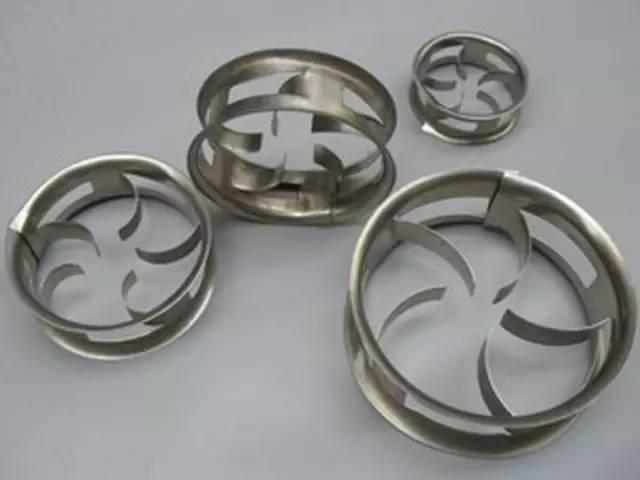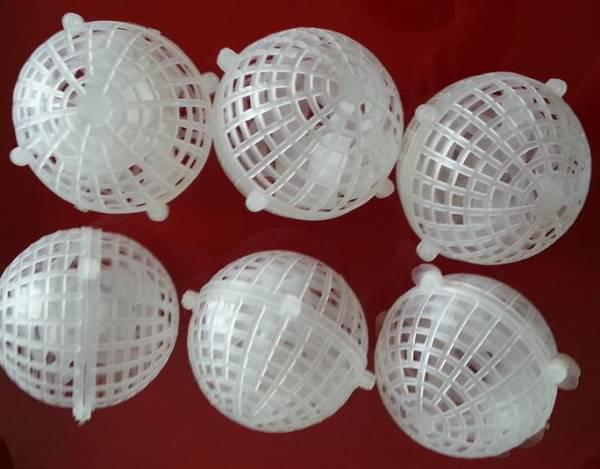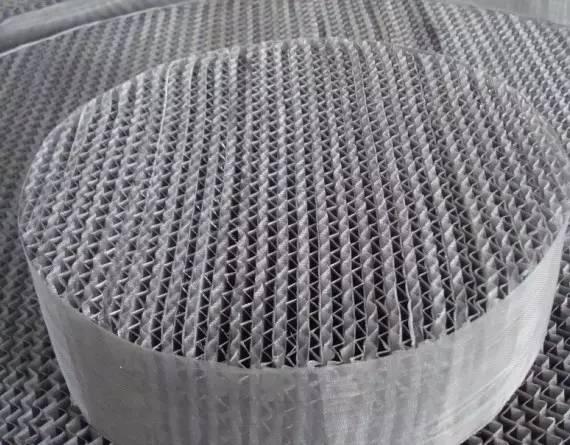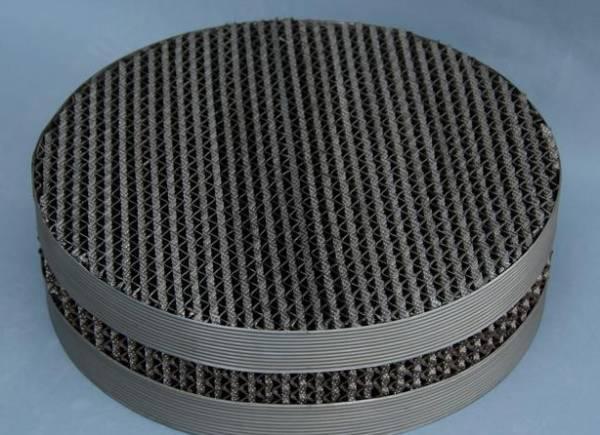Types and selection of fillers
Types and selection of fillers
Definition of filler
Filler refers to materials that are filled in other objects.
In engineering, packing refers to inert solid materials loaded in a packed tower, such as ball rings and Raschig rings, etc. Its function is to increase the contact surface between gas and liquid, so that they are strongly mixed with each other.
In products, fillers, also known as bulking agents, refer to solid materials used to improve processing performance, mechanical properties of products and/or reduce costs.
In the field of sewage treatment, it is mainly used in contact oxidation process. Microorganisms will accumulate on the surface of the filler to increase the surface contact with the sewage and degrade the sewage.
Advantages: simple structure, small pressure drop, easy to manufacture with corrosion-resistant non-metallic materials, etc. It is quite suitable for gas absorption, vacuum distillation
Disadvantages: When the tower neck is enlarged, it causes uneven gas-liquid distribution, poor contact, etc., resulting in a decrease in efficiency, which is called the amplification effect . At the same time, the packed tower also has the disadvantages of heavy weight, high cost, troublesome cleaning and maintenance, and large packing loss.
Filler selection criteria
The geometric property data of fillers mainly include specific surface area, porosity, filler factor, etc., which are basic parameters for evaluating filler performance.
(1) Specific surface area The surface area of a packing per unit volume is called specific surface area, which is represented by a and its unit is m2/m3. The larger the specific surface area of the packing, the larger the gas-liquid mass transfer area it provides. Therefore, specific surface area is an important indicator for evaluating the performance of packing.
(2) Porosity The volume of voids per unit volume of filler is called porosity, which is represented by e and its unit is m3/m3, or expressed in %. The larger the porosity of the filler, the greater the ability of gas to pass through and the lower the pressure drop. Therefore, porosity is another important indicator for evaluating the performance of fillers.
(3) Packing factor The ratio of the specific surface area of the packing to the cube of the porosity, i.e. a/e 3, is called the packing factor, denoted by f, with the unit of 1/m. It indicates the fluid mechanics properties of the packing. The smaller the f value, the smaller the flow resistance.
The performance of the filler depends mainly on:
Larger specific surface area (m2/m3 packing layer)
The liquid has better uniform distribution performance on the filler surface
The airflow can be evenly distributed in the packing layer
The seasoning has a large porosity (m3/m3 packing layer).
Under the same operating conditions, the larger the specific surface area of the filler, the more uniform the gas-liquid distribution, and the better the surface wetting performance, the higher the mass transfer efficiency; the larger the porosity of the filler and the more open the structure, the greater the flux and the lower the pressure drop.
The performance of nine commonly used packings was evaluated by fuzzy mathematics method. The wire mesh corrugated packing had the best comprehensive performance, while the Raschig ring had the worst.
The selection of fillers includes determining the type, specification and material of the fillers, etc. The selected fillers must not only meet the requirements of the production process, but also minimize the equipment investment and operating costs.
1
Selection of filler type
The selection of filler type should take into account the requirements of the separation process, usually considering the following aspects:
1) The mass transfer efficiency is higher. Generally speaking, the mass transfer efficiency of structured packing is higher than that of bulk packing.
2) The flux should be large. On the premise of ensuring high mass transfer efficiency, fillers with high flooding point gas velocity or gas phase kinetic energy factor should be selected.
3) The pressure drop of the packing layer should be low.
4) The packing has strong anti-fouling and anti-clogging performance and is easy to disassemble, assemble and maintain.
2
Selection of packing specifications
Packing specification refers to the nominal size or specific surface area of the packing.
(1) Selection of bulk filler specifications
The commonly used bulk fillers in industrial towers mainly include DN16, DN25, DN38, DN50, DN76 and other specifications.
For the same type of filler, the smaller the size, the higher the separation efficiency, but the resistance increases, the flux decreases, and the filler cost increases a lot. When large-sized fillers are used in small-diameter towers, poor liquid distribution and severe wall flow will occur, reducing the tower's separation efficiency.
Therefore, there should be a regulation for the ratio of tower diameter to packing size. Generally, the ratio of tower diameter to packing nominal diameter D/d should be greater than 8.
(2) Selection of structured packing specifications
There are many ways to express the models and specifications of structured packings commonly used in industry. In China, it is customary to express them by specific surface area. The main specifications include 125, 150, 250, 350, 500, 700, etc.
For the same type of structured packing, the larger the specific surface area, the higher the mass transfer efficiency, but the resistance increases, the flux decreases, and the packing cost also increases significantly.
When selecting, comprehensive consideration should be given to separation requirements, flux requirements, site conditions, material properties, equipment investment, operating costs, etc., so that the selected filler can meet the technical requirements and be economically reasonable.
3
Selection of filler material
The materials of fillers are divided into three categories: ceramics, metals and plastics.
(1) Ceramic filler
Ceramic fillers have good corrosion resistance and heat resistance. Ceramic fillers are cheap and have good surface wettability. Their biggest disadvantage is that they are brittle and easy to break. They are widely used in gas absorption, gas washing, liquid extraction and other processes.
(2) Plastic fillers
The materials of plastic packing mainly include polypropylene (PP), polyethylene (PE) and polyvinyl chloride (PVC), etc. Polypropylene is generally used in China. Plastic packing has good corrosion resistance and can resist corrosion from general inorganic acids, alkalis and organic solvents. It has good temperature resistance and can be used for a long time below 100 ℃ .
Plastic fillers are light, cheap, have good toughness, are impact-resistant, not fragile, and can be made into thin-walled structures. They have large flux and low pressure drop and are often used in absorption, desorption, extraction, dust removal and other devices.
The disadvantage of plastic fillers is their poor surface wetting properties, but their surface wetting properties can be improved through appropriate surface treatment.
(3) Metal filler
Metal fillers can be made of a variety of materials, and corrosion is the main consideration when choosing.
Carbon steel filler has low cost and good surface wetting properties, and should be given priority for non-corrosive or low-corrosive systems.
Stainless steel packing has strong corrosion resistance and is generally resistant to corrosion from common systems except Cl-, but its cost is relatively high and its surface wettability is relatively poor. In some special occasions (such as vacuum distillation process under extremely low spray density), its surface needs to be treated to achieve good results.
Fillers made of materials such as titanium and special alloy steel are very expensive and are generally only used in certain extremely corrosive systems.
Generally speaking, metal fillers can be made into thin-walled structures. They have large flux, small gas resistance, and high impact resistance. They can be used under high temperature, high pressure, and high impact strength, and have the widest range of applications.
Types of fillers
1
Raschig Ring Packing
Raschig ring packing was invented by F. Rashching in 1914. It is a circular ring with equal outer diameter and height. Raschig ring packing has poor gas-liquid distribution, low mass transfer efficiency, high resistance and low flux, and is rarely used in industry.

2
Ball ring packing
Ball ring packing is an improvement on the Raschig ring. Two rows of rectangular window holes are opened on the side wall of the Raschig ring. One side of the cut ring wall is still connected to the wall surface, and the other side is bent inward to form an inwardly extending tongue blade, and the side edges of the tongue blades overlap in the center of the ring.
Ball rings have holes in the ring wall, which greatly improves the utilization of the inner space and the inner surface of the ring, reduces air flow resistance, and evenly distributes liquid. Compared with Raschig rings, the gas flux of ball rings can be increased by more than 50%, and the mass transfer efficiency is increased by about 30%. Ball rings are a widely used filler.

3
Step ring packing
The step ring packing is an improvement on the ball ring. Compared with the ball ring, the height of the step ring is reduced by half and a conical flange is added at one end.
Due to the reduction of the height-to-diameter ratio, the average path of the gas around the outer wall of the packing is greatly shortened, reducing the resistance of the gas passing through the packing layer. The conical flange not only increases the mechanical strength of the packing, but also changes the line contact between the packing to point contact, which not only increases the gap between the packing, but also becomes the gathering and dispersion point for the liquid flowing along the surface of the packing, which can promote the surface renewal of the liquid film and is conducive to improving the mass transfer efficiency.
The comprehensive performance of the step ring is better than that of the ball ring, making it the most excellent type of annular packing used.

4
Arc saddle packing
Arc saddle filler is a kind of saddle-shaped filler. Its shape is like a saddle and it is generally made of porcelain material.
The characteristics of arc saddle packing are that the surface is completely open, regardless of inside or outside, the liquid flows evenly on both sides of the surface, the surface utilization rate is high, the flow channel is arc-shaped, and the flow resistance is small.
Its disadvantage is that it is easy to overlap, causing part of the packing surface to overlap, which reduces the mass transfer efficiency. The arc saddle packing has poor strength and is easy to break, so it is not widely used in industrial production.
5
Rectangular saddle packing
The rectangular saddle filler changes the arc surfaces at both ends of the arc saddle filler into rectangular surfaces, and the two surfaces are of unequal sizes, which becomes a rectangular saddle filler.
When the rectangular saddle packing is piled up, it will not overlap, and the liquid is evenly distributed. The rectangular saddle packing is generally made of porcelain material, and its performance is better than that of Raschig ring. In most domestic applications where porcelain Raschig rings are used, they have been replaced by ceramic rectangular saddle packing.

6
Metal ring saddle packing
Ring-shaped saddle packing (known as Intalox abroad) is a new type of packing designed with the characteristics of both ring-shaped and saddle-shaped structures. This packing is generally made of metal, so it is also called metal ring-shaped saddle packing.
Ring-shaped saddle packing combines the advantages of both ring-shaped packing and saddle-shaped packing. Its comprehensive performance is better than that of ball rings and step rings, and it is widely used in bulk packing.
7
Spherical packing
Spherical fillers are generally made of plastic injection molding and have a variety of structures. The characteristic of spherical fillers is that the sphere is hollow, allowing gas and liquid to pass through it. Due to the symmetry of the spherical structure, the packing density is uniform, and it is not easy to produce cavities and bridges, so the gas-liquid dispersion performance is good. Spherical fillers are generally only suitable for certain specific occasions and are rarely used in engineering.

In addition to the above-mentioned typical bulk fillers, new fillers with unique configurations are constantly being developed, such as conjugated ring fillers, Haier ring fillers, and Nater ring fillers.
8
Structured packing
Structured packing is a packing that is arranged in a certain geometric shape and stacked neatly. There are many types of structured packing, which can be divided into grid packing, corrugated packing, etc. according to their geometric structure.
Grid filler
Grid fillers are made of strip units combined in a certain rule and have various structural forms. The earliest grid filler used in industry is wooden grid filler.
The most commonly used ones are Glidge grid packing, mesh grid packing, honeycomb grid packing, etc. Among them, Glidge grid packing is the most representative. The grid packing has a low specific surface area and is mainly used in occasions requiring small pressure drop, large load and anti-blocking.

Corrugated packing
Corrugated packing Most of the structured packing used in industry is corrugated packing, which is a disc-shaped packing composed of many corrugated thin plates. The inclination angle between the corrugation and the tower axis is 30° and 45°. When assembling, two adjacent corrugated plates are stacked in opposite directions. Each plate of packing is installed vertically in the tower, and the adjacent plates are staggered at 90°.

Corrugated packing can be divided into two categories according to its structure: mesh corrugated packing and plate corrugated packing , and its materials can be divided into metal, plastic and ceramic.
Metal mesh corrugated packing is the main form of mesh corrugated packing, which is made of metal mesh. Metal mesh corrugated packing has low pressure drop and high separation efficiency, and is particularly suitable for precision distillation and vacuum distillation devices, providing an effective means for the distillation of difficult-to-separate systems and heat-sensitive systems. Although it is expensive, it is still widely used due to its excellent performance.

Metal plate corrugated packing is a main form of plate corrugated packing. The corrugated plate of this packing is punched with many small holes of about f5mm, which can roughly distribute the liquid on the plate and strengthen the horizontal mixing. The corrugated plate is rolled into fine grooves, which can finely distribute the liquid on the plate and enhance the surface wetting performance. Metal perforated plate corrugated packing has high strength and strong corrosion resistance, and is particularly suitable for large diameter towers and occasions with large gas-liquid loads.

Metal rolled hole plate corrugated packing is another representative plate corrugated packing. The main difference between it and metal hole plate corrugated packing is that the plate surface is not punched, but punctured. The plate is rolled to produce dense small puncture holes with a diameter of 0.4-0.5mm. Its separation ability is similar to that of mesh corrugated packing, but its anti-blocking ability is stronger than that of mesh corrugated packing, and it is cheaper and more widely used.
The advantages of corrugated packing are compact structure, small resistance, high mass transfer efficiency, large processing capacity, and large specific surface area (commonly used are 125, 150, 250, 350, 500, 700, etc.). The disadvantages of corrugated packing are that it is not suitable for handling materials with high viscosity, easy to aggregate or with suspended matter, and it is difficult to load and unload and clean, and the cost is high.
Pulse Filler
Pulse packing is a kind of regular packing which is composed of hollow prismatic individuals with necks, assembled in a certain way.
After the pulse packing is assembled, a porous prismatic channel with a constriction is formed. The longitudinal flow channel shrinks and expands alternately, and strong turbulence is generated when the gas and liquid phases pass through. In the constriction section, the gas velocity is the highest and the turbulence is intense, thereby enhancing mass transfer. In the expansion section, the gas velocity is reduced to the minimum, and the separation of the two phases is achieved. The alternating contraction and expansion of the flow channel realizes the "pulse" mass transfer process.
The characteristics of pulse packing are large processing capacity and small pressure drop, which makes it an ideal packing for vacuum distillation. Because of its excellent liquid distribution performance, it reduces the amplification effect and is particularly suitable for large tower diameter occasions.
9
PTFE packing
PTFE valve stem packing is a soft product made of PTFE fine powder using a new process. It is white, continuous rope-shaped, and has a round cross-section. It has high flexibility, excellent filling, self-lubricating, low friction coefficient, and corrosion resistance.

advantage:
The filling is convenient and quick. When filling, it is generally not necessary to disassemble the valve. You only need to wrap the rope packing around the valve stem, push it into the stuffing box, tighten the box cap, and the packing will be pressed into a dense whole.
Excellent sealing performance. The unique microstructure of expanded polytetrafluoroethylene gives the product excellent flexibility and moldability, making it easy to fill the internal gaps of the stuffing box and even all the pits and grooves on the valve stem and box body, which also avoids the replacement or repair of corroded and worn old valves.
Long service life. Because it maintains soft plasticity for a long time, the leakage gap can be filled at any time. It is also not corroded and will not age, so it can be used for a long time.
The valve opens and closes flexibly and easily because PTFE has the lowest friction coefficient and excellent self-lubricating properties.
It does not pollute the fluid in the pipeline. Because it is white and clean, and will not fall off due to corrosion and aging, it is particularly suitable for the pharmaceutical, fine chemical, food and other industries.
The specifications are universal, reducing the amount of packing storage and saving costs. You only need to prepare a few sizes of stem packing to meet the needs of most valves.
Generally, the largest size of this type of packing that can be embedded by hand is selected, but finer sizes of this type of packing can also be used in large-sized valves. After being compressed, it will also be molded to obtain a dense sealing body.
10
Plastic filler
Plastic fillers are formed by die pressing. When used, they do not need to be cut and coiled into a ring like braided fillers. Instead, they are made into a ring according to the size of the shaft neck. Plastic fillers are available in two forms: cotton-like and laminated.
Sponge filling
Sponge filler is a mixture of fiber, graphite, mica, metal powder (or metal flakes), grease and elastic adhesive, molded into a ring shape, and then woven with a layer of asbestos yarn on the outside (metal wire can also be used as needed).
Another way of using it is to put the mixture directly into the packing cavity and use it directly after it is compressed with a gland. Since the packing has no fixed size, improper packing can easily affect the sealing performance, so this method is rarely used.
The types and proportions of various mixtures in the sponge packing can be adjusted according to working conditions. For example, copper powder can be added to high-pressure steam seals, lead particles or lead sheets can be added to acidic medium seals, and more adhesives with good elasticity can be added when the shaft vibrates.
Since this packing does not contain lubricants, its volume changes very little under high pressure, and it can be used for high-speed pumps and high-pressure valve seals. If solid lubricants are added, good self-lubricating properties can be guaranteed, and the structure is dense, which helps to improve the sealing performance. In addition, sponge packing has plastic fluidity and can be used in combination with metal packing.
Laminated filler
This type of filler is formed by coating rubber on the surface of asbestos cloth or canvas, and then hot-pressing and vulcanizing it after stacking or winding. It can also be sandwiched with soft fillers such as rubber cores or embedded with springs, and has a structure of several layered fillers.
The laminated packing has good sealing performance and can be used for low-pressure steam, water and ammonia liquid below 120℃. It is mainly used as a reciprocating shaft seal and valve stem seal. The ring-mounted laminated packing without interface can also be used as a reciprocating pump piston ring. Since the lubricant contained in the laminated packing is insufficient, lubricant needs to be added during use.
Made in China Mao Qun stainless steel wire mesh, stainless steel screen mesh, stainless steel woven mesh, nickel alloy wire mesh, copper wire mesh, screen mesh,GFW metal wire mesh,Stainless steel wire mesh,Alloy wire mesh,Knitted metal wire mesh,Woven Wire Mesh,Structured packing